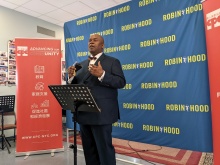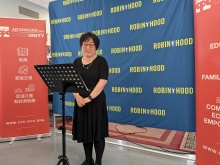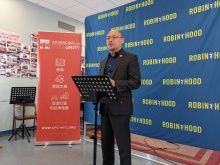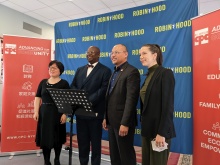CPC Hosts the Release of Robin Hood's Annual Poverty Tracker Report

On Tuesday, May 5th, CPC hosted the release of Robin Hood's 4th annual Poverty Tracker Report, in collaboration with Columbia University, spotlighting the experience of Asian American New Yorkers living in poverty. Although Asian Americans are the fastest growing racial group the United States, the community is often underrepresented in research. This report also examines the role that government policy played in preventing a sudden increase in poverty driven by the pandemic, while also showing that economic disadvantages remain widespread and disproportionately impact Asian, Latinx, and Black New Yorkers.
Spotlight on Asian New Yorkers:
- Asian Americans are among the most understudied racial and ethnic groups in the U.S. and are underrepresented in many data sources, including those that collect information on poverty and economic disadvantage. Robin Hood’s targeted research found that roughly one in four Asian New Yorkers lived in poverty in 2020 — comparable to the share of Black and Latinx New Yorkers living in poverty and double the poverty rate for white New Yorkers. Nearly half of Asian New Yorkers (47%) faced some form of disadvantage, especially among those aged 65 or older and those with a high school degree or less or limited English proficiency.
- The latest Poverty Tracker sample includes Asian New Yorkers from more than thirty countries of origin other than the United States, including China, Bangladesh, India, Korea, Pakistan, and the Philippines, among others.
- In 2020, the Poverty Tracker expanded its reach by sampling Mandarin Chinese speakers to better understand the dynamics of disadvantage among Asian New Yorkers.
Highlights on All New Yorkers:
- Income Poverty and Corresponding Policies: Government policies, including direct cash transfers and tax credits, kept the poverty rate in New York City from rising sharply during the pandemic. Pre-pandemic, tax credits and government policies reduced the poverty rate from 28% to 18%, or a 36% reduction. But in 2020, these policies helped cut the poverty rate by more than 56%. Altogether, tax credits and government policies moved 1.9 million New Yorkers out of poverty.
- Material Hardship and Inadequacies: In 2020, 29% of adults and 38% of children were in a family facing material hardship – measured by facing material hardship, such as not being able to afford food, housing, utility payments or a doctor’s visit during the last 12 months. Roughly 41% of Latinx New Yorkers, 36% of Black New Yorkers, and 27% of Asian New Yorkers faced material hardship, compared to 15% of white New Yorkers. Overall, the most common form of material hardship facing New Yorkers in 2020 was medical hardship, or the inability to see a doctor due to affordability.
- Health Access Detriments: New Yorkers encountering material hardship or facing poverty were nearly twice as likely to have a health problem. Latinx and Black New Yorkers were 40% more likely to be dealing with health problems than white New Yorkers.
- Layered Disadvantages: In 2020, nearly 50% of New Yorkers faced some form of disadvantage – poverty, material hardship, or health problems – and 16% faced multiple forms of disadvantage. Twenty-eight percent of New Yorkers facing multiple forms of disadvantages were also experiencing serious psychological distress, versus 3% of New Yorkers not facing multiple disadvantages.
Richard R. Buery, Jr., CEO of Robin Hood said, “This report illustrates what we’ve seen across our city – that too many people are struggling, and poverty remains persistent and pervasive. There are nearly four million New Yorkers who face economic disadvantages, material hardships, or live below the poverty level; that is nearly equal to the population of Los Angeles, the nation’s second-largest city. New Yorkers are strong, but even the strong need help. We need government and philanthropy to work together to realize progress in the fight against poverty. This report shows that government policies and investments during the COVID-19 pandemic had a real and positive impact on poverty in New York City. But many of those policies were temporary, and New Yorkers are at risk. It will take all of us working together, the government and our communities, to ensure that every New Yorker has the fair shot they deserve.”
Since 2012, the Poverty Tracker has surveyed a representative sample of 3,000 New York households every three months, providing critical information on the dynamics of poverty and other forms of disadvantage in the city while tracking data on employment, assets and debts, and health. The Poverty Tracker has monitored the impacts that COVID-19 and the related economic downturn have had on life in New York City since the onset of the pandemic.
Qin Gao, Professor at Columbia University School of Social Work and Director of China Center for Social Policy said, “For the first time in our study, we are able to take a closer look at the Asian American population in New York City. This is important because, similar to Black and Latino communities, we find that nearly one in four Asian adults in New York City lived in poverty in 2020. However, we rarely talk about poverty in the Asian American community in public discourse. Without the data, it is easy to stereotype based on the highly educated and visible segments of the population, but the community is not a monolith. We find real vulnerabilities when we look at older adults, people with less education, and community members with less English proficiency and these need to be addressed through culturally and linguistically supportive services. Moreover, our survey picked up on increased stress related to the surge of racial discrimination and attacks against people of Chinese descent and other Asian ethnicities during the pandemic, an added dimension to the experiences of poverty and hardship. We will continue to share as we learn more about the experiences and needs of Asian Americans in New York City and urge others around the country to do the same.”
Wayne Ho, President, and CEO of the Chinese American Planning Council said, “The dual pandemics of COVID and anti-Asian hate brought even more hardship on our communities in the last couple of years. This report sheds light on what our community is feeling while pointing toward a real need for bold investments from lawmakers to tackle poverty in our city. We have seen the benefits of influential, intentional poverty-fighting policies in New York City and have evidence that change is in our grasp, but many of those policies have expired and several continued to exclude immigrant families. Now is not the time to waver. We need bold government policies and resources that can keep all New Yorkers out of poverty and on the path toward economic mobility.”
Read the full report here. Read the Chinese translation of the report here.





